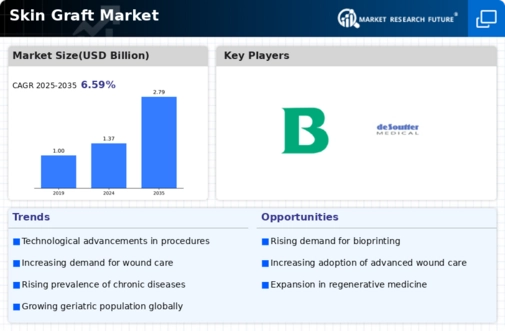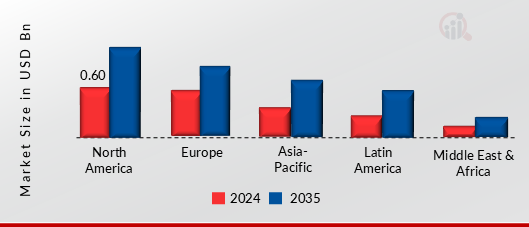Market Growth Projections
The Global Skin Graft Market Industry is poised for substantial growth, with projections indicating an increase from 1.37 USD Billion in 2024 to 2.79 USD Billion by 2035. This growth trajectory reflects a compound annual growth rate (CAGR) of 6.68% from 2025 to 2035. Factors contributing to this expansion include advancements in surgical techniques, rising awareness of skin graft procedures, and an increasing geriatric population. Additionally, the emergence of biologics and regenerative medicine is expected to further enhance market dynamics. These projections underscore the potential for innovation and development within the skin graft sector, highlighting its importance in addressing diverse medical needs.
Rising Geriatric Population
The aging population is a significant driver of the Global Skin Graft Market Industry. As individuals age, they become more susceptible to skin injuries and chronic wounds, necessitating advanced treatment options such as skin grafts. The demographic shift towards an older population is expected to increase the prevalence of conditions requiring skin grafting, thereby expanding market opportunities. With the projected market growth from 1.37 USD Billion in 2024 to 2.79 USD Billion by 2035, the geriatric demographic is likely to play a crucial role in shaping the future landscape of skin grafting procedures and technologies.
Rising Incidence of Burn Injuries
The Global Skin Graft Market Industry is experiencing growth due to the increasing incidence of burn injuries worldwide. According to health statistics, burn injuries account for a significant number of hospital admissions, necessitating advanced treatment options such as skin grafts. In 2024, the market is projected to reach 1.37 USD Billion, driven by the need for effective wound healing solutions. As awareness of burn treatment improves, more patients seek surgical interventions, further propelling market demand. This trend indicates a growing recognition of the importance of skin grafts in restoring skin integrity and function, thus enhancing patient outcomes.
Advancements in Surgical Techniques
Innovations in surgical techniques are playing a pivotal role in the expansion of the Global Skin Graft Market Industry. Techniques such as minimally invasive surgery and robotic-assisted procedures are enhancing the precision and efficacy of skin grafting. These advancements not only reduce recovery times but also improve overall patient satisfaction. As a result, healthcare providers are increasingly adopting these modern techniques, contributing to the market's growth. The anticipated CAGR of 6.68% from 2025 to 2035 reflects the potential for continued advancements in surgical methodologies, which are expected to further elevate the demand for skin grafts.
Increasing Awareness of Skin Graft Procedures
The Global Skin Graft Market Industry is benefiting from heightened awareness regarding skin graft procedures among both healthcare professionals and patients. Educational initiatives and campaigns are informing stakeholders about the benefits and advancements in skin grafting techniques. This increased awareness is likely to lead to more patients opting for skin grafts as a viable treatment option for various skin injuries and conditions. As the market evolves, the projected growth from 1.37 USD Billion in 2024 to 2.79 USD Billion by 2035 underscores the potential impact of awareness on market dynamics, driving demand for innovative skin graft solutions.
Emergence of Biologics and Regenerative Medicine
The Global Skin Graft Market Industry is witnessing a surge in the adoption of biologics and regenerative medicine. These innovative therapies are designed to enhance the healing process and improve graft integration. The incorporation of biologics into skin grafting procedures is expected to lead to better patient outcomes and reduced complications. As the market evolves, the integration of these advanced therapies is likely to drive growth, with a projected CAGR of 6.68% from 2025 to 2035. This trend indicates a shift towards more effective and holistic approaches in treating skin injuries, further solidifying the role of skin grafts in modern medicine.














Leave a Comment